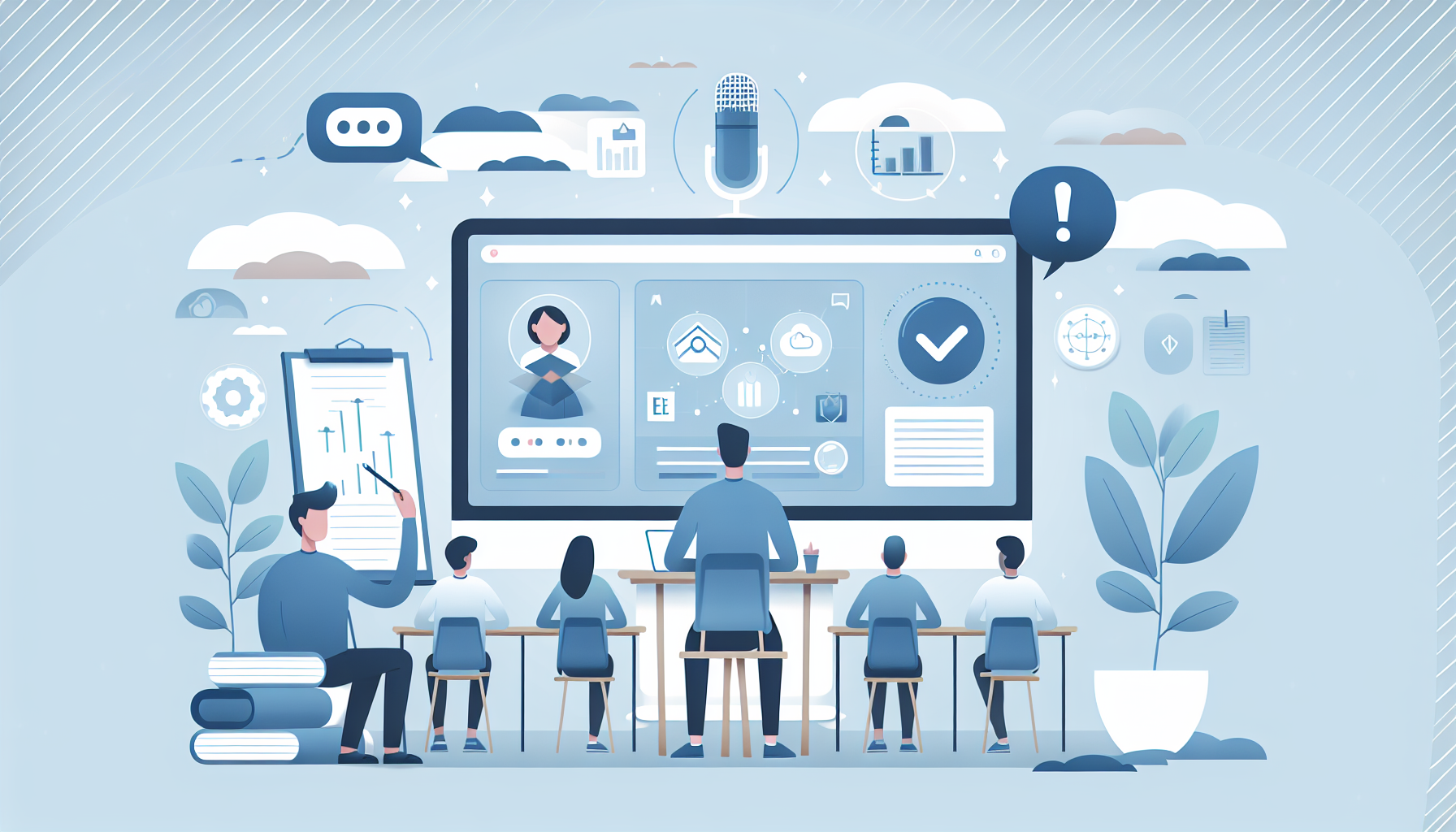Navigating virtual classrooms can feel like trying to juggle flaming torches—especially when it comes to providing real-time feedback. You might be wondering how to keep students engaged and provide them with the instant responses they crave, all while managing the digital chaos. Don’t worry; you’re not alone in this!
If you stick with me, I’ll share some effective strategies and tools that can transform your feedback game. By the end of this, you’ll have a toolkit filled with practical tips to give feedback that not only counts but also resonates with your students.
We’ll dive into interactive methods, the tech you need, and even tackle some of the trickier challenges. Trust me, your virtual classroom will be buzzing with engagement in no time!
Key Takeaways
- Real-time feedback boosts engagement, learning, and allows immediate teaching adjustments in virtual classrooms.
- Use interactive tools like polls (Kahoot!, Mentimeter) to gather quick student responses during lessons.
- Encourage questions through chat features for instant clarification of concepts and misunderstandings.
- Feedback should be specific, timely, and include peer reviews to create a collaborative environment.
- Incorporate engaging methods like gamification and breakout rooms to enhance student participation.
- Measure feedback impact through grades, engagement metrics, and student surveys to assess effectiveness.

Effective Strategies for Real-Time Feedback in Virtual Classrooms
Real-time feedback is a game changer in virtual classrooms. It fosters engagement, facilitates learning, and allows for immediate adjustments in teaching strategies. When feedback is timely, students are more likely to understand concepts clearly and feel supported in their learning journey.
One effective strategy is to use polls or quizzes during classes. Tools like Kahoot! or Mentimeter allow instructors to gather quick responses. This not only makes lessons interactive but also provides instant insight into student comprehension.
Another approach is employing chat features for students to ask questions in real-time. Encourage students to voice their queries or opinions during discussions. This can help instructors gauge understanding and clarify misconceptions immediately.
Importance of Real-Time Feedback in Online Learning
Real-time feedback is crucial in online learning because it helps bridge the gap that distance can create. It transforms the learning atmosphere from a one-way lecture to an engaging conversation between students and instructors.
When students receive immediate feedback, they can adjust their learning strategies on the spot. This not only boosts confidence but also reinforces learning as they see the direct implications of their actions.
Additionally, it builds a community. Students feel more connected when they know their contributions are seen and valued, making them more likely to participate actively.
Tools and Technology for Providing Instant Feedback
There are numerous tools designed to enhance real-time feedback in virtual classrooms. Platforms like Google Classroom and Canvas include features that allow for quick assessments and feedback delivery.
Moreover, video conferencing tools such as Zoom have polling features that can collect student responses instantly. This opens the door for teachers to understand the class’s pulse without waiting for formal assessments.
Collaboration boards like Padlet or Jamboard can also serve as excellent platforms for instant feedback. These tools enable students to post ideas or questions and receive peer or instructor feedback in real-time.
Best Practices for Giving Feedback in Virtual Teaching
When giving feedback in virtual teaching, clarity is key. Ensure that the feedback is specific and actionable. Instead of saying “great job,” try “your analysis was strong, but consider expanding on your examples for clarity.”
Timeliness is also crucial. Offer feedback as soon as possible after assessments or discussions to keep the experience fresh for the student.
It’s beneficial to encourage peer feedback as well. Create opportunities for students to give each other constructive criticism, fostering a collaborative learning environment.
Finally, consider the medium of your feedback. A mix of written comments, voice notes, and video feedback can make the process more personalized and engaging for students.

Engaging Students with Interactive Feedback Methods
Keeping students engaged through feedback is vital in a virtual classroom setting.
Interactive methods not only sustain participation but also enhance the learning experience.
One effective technique is using gamification. You can turn feedback into a game where students earn points for correctly answering questions based on the feedback.
Tools like Kahoot! or Quizizz make this process easy to implement.
Another interactive method is to create breakout rooms during video calls where small groups can discuss feedback, brainstorm solutions, and present their thoughts to the larger group.
This not only adds a layer of interaction but also encourages collaboration among students.
Utilizing presentations where students can reflect on and provide peer feedback can also reinforce understanding.
By integrating these techniques, you’re likely to see a boost in morale and motivation among your students.
Measuring the Impact of Real-Time Feedback on Student Learning
Measuring the impact of real-time feedback is essential for understanding its effectiveness.
Begin by establishing clear metrics for success, such as improvement in grades, engagement levels, or student self-assessments.
Surveys can be a powerful tool here; deploying simple questionnaires after classes can provide insight into how students feel about the feedback they receive.
You may also want to compare assessments before and after implementing real-time feedback strategies, tracking academic improvement over time as a tangible measure of impact.
Analyzing participation rates in feedback activities can also reveal students’ engagement levels.
Lastly, observe qualitative outcomes, such as increased confidence in class participation and a stronger sense of community. These indicators will help gauge the broader implications of your feedback methods.

Challenges and Solutions for Implementing Real-Time Feedback
Implementing real-time feedback in virtual classrooms can come with its own set of challenges.
One common hurdle is technology issues, such as unstable internet connections or software glitches.
To combat this, ensure that both teachers and students have access to reliable technology.
Conducting a tech check before classes can save a lot of headaches later.
Another challenge is student engagement; sometimes, students may not respond in real-time feedback sessions.
This can be tackled by creating a safe space where students feel comfortable participating.
Encouraging participation through incentives or gamifying the feedback process can also help boost engagement.
Lastly, the sheer volume of feedback can be overwhelming for instructors.
Using streamlined tools that condense feedback into manageable formats can ease this burden.
For example, employing platforms like Google Forms or SurveyMonkey can help organize student responses efficiently.
Future Trends in Real-Time Feedback for Virtual Classrooms
The future of real-time feedback in virtual classrooms is likely to be shaped by advancements in technology and pedagogy.
Artificial Intelligence is on the horizon, with tools designed to analyze student responses instantly.
This means that instructors could receive tailored insights on each student, adapting their methods accordingly.
Another trend to watch is the growth of analytics in education.
Instructors will be able to track individual progress in real-time, allowing for instant adjustments to lesson plans.
Augmented and virtual reality may also play a role, creating immersive feedback experiences.
Imagine students receiving feedback in a simulated environment where they can immediately apply it.
Lastly, the focus on student well-being is expected to grow.
Feedback that emphasizes emotional and mental support alongside academic progress will become more prevalent.
FAQs
Real-time feedback enhances student engagement, allows for immediate correction of misunderstandings, and boosts motivation. It promotes a responsive learning environment where students can actively participate and improve their learning outcomes.
Popular tools for instant feedback include platforms like Google Forms for quizzes, Kahoot for interactive games, and discussion features in Zoom or Microsoft Teams. These tools facilitate timely responses and enhance student interaction.
Best practices include being specific and constructive, delivering feedback promptly, utilizing varied methods (e.g., video, audio, text), and encouraging a two-way communication channel for clarification and further questions.
The impact can be measured through assessments of student performance, tracking engagement metrics, conducting surveys for self-reported learning experiences, and analyzing completion rates of assignments and participation levels.
